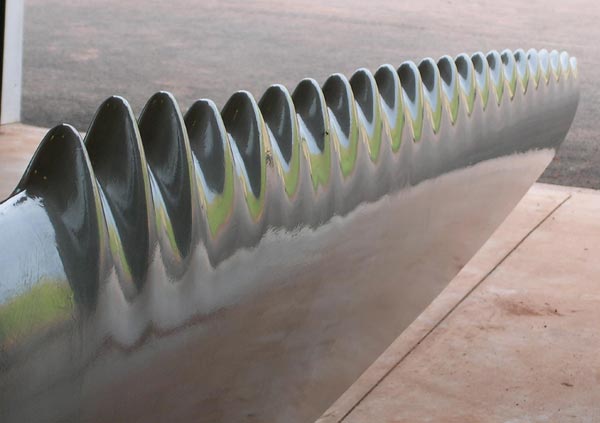Wind Turbine Inspiration from Whales.
With all their grace and beauty, whales may hold the key to designing the next generation of renewable energy technology.
There aren't many sights from the animal kingdom that can compare to the breaching of a 30-tonne humpback whale (Megaptera novaeangliae). These huge marine mammals can reach heights of 15 metres as they break through the ocean's surface.
This is partially thanks to the aerodynamics of their five-metre-long pectoral fins. The front limbs of whales are the largest appendages of any animal on earth, and it is the small bumps called tubercles found along the leading edge that give them their amazing acrobatic skills.
These bumps change the way that water flows over the whale's fins. Frank Fish, a biologist at West Chester University explains: "If a whale wants to make a tight turn, it'll need more lift, from a higher angle of attack...But if that angle of attack is too great when it's trying to make that circle, it'll stall - just like a stomach-dropping moment in an airplane or skidding on black ice in a car."

Research into the whales' tubercles has been conducted both at Harvard University as well as the US Naval Academy in Maryland, revealing amazing possible implications for a range of technology.
Scientists at Harvard demonstrated how the hydrodynamic edge works using a mathematical model. They found that these bumps change the distribution of pressure along the pectoral fin and due to this variation, different areas of the fin stall with different angles of attack - making sudden stalls easier to avoid. They concluded that this gives the whale "more freedom to attack at higher angles and the ability to better predict its hydrodynamic limitations."
This research was then further developed by researchers at the US Naval Academy, who found that biomimetic fins based on this model reduced drag by a third and improved lift by 30%. They suggested that this could lead to "more-stable aeroplane designs, submarines with greater agility, and turbine blades that can capture more energy from wind or water."
This research is now being applied in the real world by Toronto-based company Whale Power, who are taking inspiration from these remarkable tubercles to develop wind turbine blades that mimic the pectoral fins of the marine mammals.

While these blades are still undergoing in-house testing, experiments have shown that they can achieve the same amount of generated energy at wind speeds of ten miles per hour that conventional blades generate at seventeen miles per hour. Whale Power's director of research and development, Stephen Dewar, has said that these biomimetic fins are "more stable, quiet and durable than conventional turbines - even withstanding being hit by the edge of a hurricane" during testing at the Wind Energy Institute of Canada.
While scientific research is often undertaken purely in the spirit of curiosity and academic interest, these kinds of intriguing discoveries that may have practical applicability in the modern world are exciting and welcome. With the planet's climate becoming increasingly unstable and inhospitable to human life as a consequence of the worldwide burning of fossil fuels, the need for efficient and optimised renewable energy sources has never been greater. Yet with the anatomy of wild species already fine-tuned for their purpose over millennia of evolution, researchers have realised that there's no need to reinvent the wheel - or the fin.
Author: Thomas Llewellyn
Reference:
Fish, F.E., P.W. Weber, M.M. Murray, and L.E. Howle. 2011. "The
tubercles on humpback whales' flippers: application of bio-inspired
technology." Integrative and Comparitive Biology 51(1):203-13. doi: 10.1093/icb/icr016
Whether part of invention or innovation, many engineers have found inspiration in nature simply because many of mother nature's designs have evolved to be far more efficient than any man-made creation. The concept of biomimicry, the production of models based on biological entities, has given us more efficient wind turbines from the fins of whales,...




